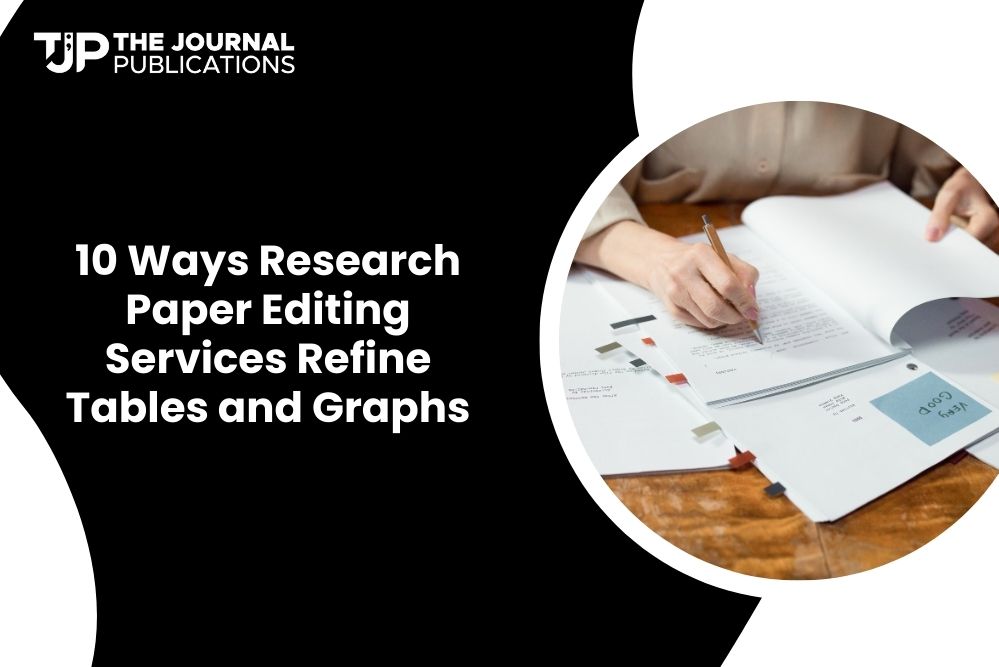Intro
Data presentation is the backbone of any research paper. Tables and graphs allow researchers to present their findings through visual means. They clarify and emphasize key data points. Yet, poor visuals can cause confusion and misinterpretation. They may even lead to rejection from academic journals. Research paper editing services can help. They refine your visuals to improve their quality. We explore 10 ways these services improve your tables and graphs. They ensure precision, clarity, and compliance with journal standards.
-
Aligning data with the research narrative.
A crucial aspect of effective data presentation is coherence. Editors ensure that every table and graph complements your paper’s objectives and narrative. Misaligned visuals can distract readers and weaken your argument. Editors will use their expertise to link each figure to your findings. This will ensure that the data supports your manuscript.
In academic editing, editors check if visuals support the text’s hypotheses and results. This editing makes it easy for readers to connect the data with the study’s core message.

-
Optimizing formatting for clarity
Formatting inconsistencies in tables and graphs can confuse readers. Proofreading and editing services use standard formats to present data in a clear manner.
Key enhancements include:
- Consistent use of fonts, line weights, and colors.
- Proper alignment of rows and columns in tables.
- Simplified axis labels and data markers in graphs.
For example, if you must format your research for a journal publication support and editing services will ensure your visuals are readable and meet those requirements.
-
Enhancing Visual Appeal
Beyond functionality, well-designed visuals enhance reader engagement. Editors of scientific editing services use advanced design principles. They make tables and graphs visually appealing.
Strategies for Better Design:
- Employing appropriate color schemes for better data differentiation.
- Highlight significant data points using bold font or distinct symbols.
- Avoiding cluttered visuals by focusing on essential trends.
These changes will make your visuals stand out. They will also direct readers to your key research findings.
-
Ensuring compliance with journal requirements
Journals often have stringent guidelines for tables and graphs, including:
- Least resolution for images.
- Standardized font types and sizes.
- Specific requirements for axis labels, legends, and figure numbering.
Comprehensive academic editing and proofreading services
ensure your visuals meet these criteria. By aligning the visuals with the journal’s standards, they reduce rejections.
-
Highlighting Key Insights
Overly detailed tables and graphs can overwhelm readers. Editors simplify complex data, focusing on critical insights that support your paper’s thesis.
Example:
If your table contains 20 data columns, premium editing services might suggest that you summarize it into a condensed format while ensuring that no significant information is lost. This advanced editing full support ensures your readers grasp the most important points quickly.
-
Checking Consistency Across the Manuscript
Inconsistent captions, legends, or data labels can lead to misinterpretations. Proofreading and editing services check for consistency in all visuals and text references.
Key Checks Include:
- Uniform terminology for variables.
- Cross-verification of data points between the visuals and the manuscript text.
- Consistent use of abbreviations and symbols.
These thorough checks ensure your paper meets high academic standards.
-
Improving Accessibility
Inclusivity in data presentation is essential. Professional editors use advanced features. They include colorblind-friendly palettes and clear patterns. These ensure that diverse audiences can interpret tables and graphs.
For example, editors might replace red-green contrasts with clear, universal shades. This ensures accessibility without losing clarity.
-
Ensuring Statistical Accuracy
Errors in statistical visuals can compromise the credibility of your research. With manuscript editing, editors verify the correctness of calculations and data representation. They check the raw data. They ensure that graphs and tables reflect the results.
This attention to detail protects your paper’s integrity. It shows precision and reliability to journal reviewers.
-
Addressing Redundancy
Repetitive or redundant visuals dilute the impact of your findings. Editors will remove any tables and graphs that are not needed. Each element must add unique value to the manuscript.
If two graphs show similar trends, experts may suggest merging them for a better view. This not only streamlines your paper but also enhances its readability.
-
Providing Personalized Feedback for Improvement
Academic editing services refine visuals and provide feedback. This helps researchers improve future submissions. Editors may suggest better ways to present data. They may recommend tools for creating better visuals. They may also guide researchers to avoid common mistakes.
This support turns raw data into great visuals. It makes your research stand out in the competitive academic publishing world.
Why Choose Professional Editing Services for Data Presentation?
Data presentation is an art. It needs a keen eye for detail, domain expertise, and technical precision. Proofreading and editing services help researchers. They can then submit polished, engaging manuscripts that meet journal standards.
These services provide:
- Rigorous editing for clarity and precision.
- Expertise in scientific editing services for research papers domain-specific requirements.
- Comprehensive guidance to meet the demands of leading academic journals.
With research paper editing services, your manuscript will pass peer reviews. It will also impress readers.
FAQs
-
Why do tables and graphs hold value in scholarly articles?
Tables and graphs visualize data. They help readers understand complex findings. They highlight key trends, relationships, and statistical significance in a concise manner.
-
How do editing services improve visual elements?
Editing services improve visuals by ensuring consistency and clarity. They also align with the research narrative. They also optimize formatting and ensure compliance with journal guidelines.
-
Can editing services address journal-specific formatting requirements?
Yes, editors adjust tables and graphs to meet target journals’ formats. This includes font sizes, resolutions, and labeling standards.
-
Are accessibility features included in editing services?
Many publications and editing services support accessibility. They use color-blind-friendly palettes and simple designs to promote inclusivity.
-
What are the benefits of simplifying complex data visuals?
Simplifying visuals enhances comprehension and highlights key insights. It reduces misinterpretation and strengthens your research’s impact.
-
Why is consistency in data presentation important?
Consistency eliminates confusion. It aligns visuals with the text. It ensures a professional, academic presentation. By using proofreading and editing services, researchers can improve their manuscripts. They can make them polished and professional, ready for publication. Investing in these services Enhances your research’s clarity and credibility. It also increases its chances of acceptance by top-tier journals.





